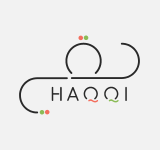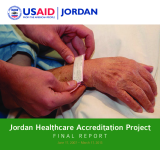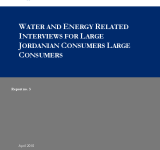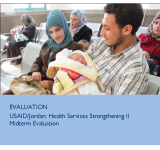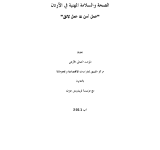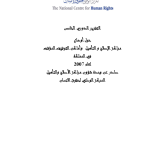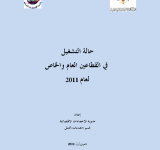facilities
نشرت هذه المعلومات المصورة من قبل الوكالة الأمريكية للتنمية الدولية في مشروع تطوير القوى البشرية العاملة في الأردن، حيث يظهر أسباب الإصابات العالية في العمل وأهمية تحسين معايير السلامة والصحة المهنية
The report aims to provide an executive summary and major results and accomplishments;; lessons learned and challenges and opportunities of the Jordan Healthcare Accreditation Project (JHAP). The overall goal of the JHAP was to improve the health status of all Jordanians and quality and safety of healthcare services through accreditation. The project's methodology was assisting the Government of Jordan to adopt a regulatory framework for the health sector;; through the establishment of national and internationally recognized healthcare standards and accreditation. The key results of the project include an organizationally and financially sustainable accrediting agency in Jordan;; the Health Care Accreditation Council (HCAC);; an HCAC board with the appropriate skills to govern the agency and support from the Ministry of Health;; the Royal Medical Services;; the university hospitals;; and the Royal Court for accreditation. The report concludes with recommendations for the HCAC in areas such as financial sustainability;; credibility of the organization;; keeping the momentum and new business development and innovation. Some opportunities that the report suggests include expanding in the Middle East and North Africa region;; partnering with well-known quality organizations;; offering courses online and benchmarking subscriptions.
The report aims to better understand and quantify the attitude and the levels of awareness amongst large consumers of water and energy;; and it presents the findings of the interviews conducted with a representative sample of large consumers to better understand trends and behaviors related to water and energy consumption. The research was conducted as part of the Jordan Public Action in Water;; Energy;; and Environment Project (PAP) under the Prosperity;; Livelihoods;; and Conserving Ecosystems (PLACE);; which aims to initiate and establish clear and identifiable behavioral changes amongst the Jordanian public and decision-makers. The study categorizes large consumers into a number of main sectors including hotel and restaurant sectors;; commercial sector;; hospitals;; government buildings and industrial sector;; and the field surveys were collected as a random sample of different industries;; state and commercial buildings. The research finds that the majority of large consumers neither monitor their water nor their energy consumptions via sub-metering scheme;; showing that the majority of large consumers are not able to accurately determine the areas within their establishments that are the most consuming. This finding identifies four major obstacles in implementing the water and energy saving practices including;; lack of awareness;; lack of incentive programs amongst employees;; higher prices for higher quality savings devices and lack of proper maintenance.
The report presents the findings;; conclusions and recommendations of a midterm evaluation of Health Systems Strengthening (HSS) II;; a five year (2009-2014);; $73 million USAID-funded project. The strategy of the HSS II is to institutionalize strengthened health systems in support of reduced fertility rates and improved women's health. It works with the public health sector;; namely the Ministry of Health;; the Royal Medical Service and the Jordan University Hospital. The report finds that the project has met 13 of its 23 targets for year 3 and is on track to meet all its objectives by the end of the project. Expected results are public sector initiatives in safe motherhood and reproductive health. The HSS II project;; with its close ties with the Ministry of Health for its responsiveness to health needs and integrated approach to health delivery;; has strengthened critical health systems through its support to health management information system;; renovations;; accreditation;; referrals and capacity-building. The report recommends the USAID to negotiate the removal of a requirement that midwives be supervised intrauterine device insertion;; advocate for innovative incentive schemes and varying salary grades that reward midwives and doctors providing FP services and revise project indicators to reflect health outcomes and impact. Further recommendations include continuing support of a broad-scale mass media behavior change and communication campaign and programs that build on gains in maternal and neonatal health.
يهدف هذا التقرير إلى تقديم قراءة تقييمية لواقع الصحة والسلامة المهنية في بيئة الأعمال الأردنية;; تتضمن قراءة في التشريعات الأردنية الخاصة بالصحة والسلامة المهنية;; إلى جانب استعراض لأبرز المعايير الدولية ذات العلاقة;; إضافة إلى تقديم قراءة لمدى موائمة التشريعات الأردنية مع المعايير الدولية في هذا المجال;; كما اعتمد التقرير في منهجيته على تحليل البيانات الاحصائية المتاحة حول الصحة والسلامة المهنية واصابات العمل;; وكما تم اجراء مقابلات مع بعض رؤساء النقابات العمالية;; وذلك إلى جانب مراجعة المعلومات والأخبار الصحية التي تناولت هذا الموضوع. ويقدم التقرير مجموعة من التوصيات التي من شأنها تحسين شروط الصحة والسلامة المهنية للعاملين في الأردن.
لقد تم إعداد هذا التقرير الخامس حول أوضاع مراكز الإصلاح والتأهيل من اجل تقييم هذه المراكز والنزلاء واماكن التوقيف والموقوفين;; وكما يكشف التقرير عن مواطن الضعف والخلل التي تعاني منها هذه المرافق. وتم الاستناد على منهجية الزيارات الميدانية الفجائية إلى تلك الاماكن;; والالتقاء بالنزلاء والموقوفين;; وكما استند التقرير أيضاً على الالتقاء بنزلاء وموقوفين سابقين وأسر بعض النزلاء الحاليين ونشطاء من المجتمع المدني.
تقرير تحليلي للعمالة والتشغيل في القطاعين العام والخاص المستند إلى نتائج مسحي الاستخدام والعمالة والبطالة لعامي 2010 و2011. وتبرز أهمية هذا التقرير من مجموعة المؤشرات التي يوفرها على شكل أرقام ونسب مئوية للعاملين وتعويضاتهم وإبراز خصائصهم التعليمية والنشاط الاقتصادي والفئات العمرية;; والحالة العملية والمهنة ومستوى الرواتب والأجور النقدية المدفوعة;; وحجم التوظيف في القطاعين العام والخاص والتي تساعد راسمي السياسات وصانعي القرار والباحثين والمهتمين في سوق العمل. ويتضمن التقرير منهجية المسحين والنتائج التحليلية لحجم العمالة من المسحين بالاضافة إلى الجداول التفصيلية للنتائج ذات العلاقة بالموضوعات التي غطاها كلا المسحين. وكما أن مسح الاستخدام يعتمد على إطار المنشآت الاقتصادية ويستثني العاملين في القطاع الزراعي والقوات المسلحة الأردنية والأجهزة الأمنية والدفاع المدني والعاملين في القطاع غير المنظم. أما مسح العمالة والبطالة فيعتمد على إطار الأسر ولا يشمل العاملين غير الأردنيين.
